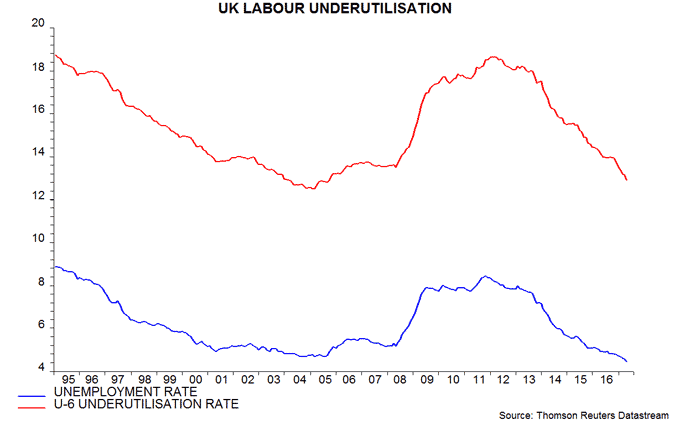The UK labour market tightened further last quarter, consistent with the view here that the economy has retained momentum and strengthening the case for a “pre-emptive” rise in interest rates, despite continued subdued pay growth.
The unemployment rate fell to 4.5% over March-May, below the MPC’s forecast of 4.7% for the second quarter in the May Inflation Report and the lowest since 1975. The single-month estimate for May was 4.4%.
The unemployment rate understated labour market slack earlier in the upswing, because there were unusually large numbers of people either working part-time involuntarily or not actively seeking employment, despite wanting a job. This “hidden” margin has eroded rapidly since 2014. A broader measure* of labour underutilisation (i.e. a UK equivalent of the US U-6 rate) fell further to 12.9% over March-May, close to a 2005 low of 12.5% in the last economic upswing – see first chart. The gap between the underutilisation and unemployment rates is the smallest since 2008.
Annual growth of average weekly earnings, including bonuses, weakened further to 1.8% over March-May, the lowest since 2014. Regular earnings growth, however, ticked up to 2.0%. Private-sector regular growth was 2.2% over March-May and 2.4% in May alone, a five-month high.
While overall pay trends remain subdued, the MPC’s assessment will also take into account recent weaker-than-expected productivity performance, faster growth of non-wage labour costs and a possible lifting of the 1% cap on public-sector pay increases.
Annual growth in aggregate weekly earnings (i.e. average earnings multiplied by the number of employees) was unchanged at 3.1% over March-May, supported by a further rise in employment expansion to 1.3%, a 10-month high – second chart. Aggregate earnings, therefore, are currently still just outpacing consumer prices – a contrast with the last inflation upsurge over 2009-11, when earnings lagged significantly.
*Total unemployed plus number working part-time because could not find full-time job plus number inactive but wanting a job, expressed as % of labour force plus number inactive but wanting a job.